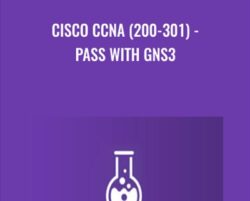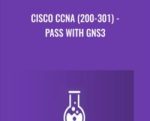Welcome to the GNS3 CCNA (200-301) course!This course helps you prepare for the newest CCNA exams (200-301 CCNA).This course is unlike other CCNA courses as it contains:Over 40 hours of video content with detailed explanations of CCNA topicsGNS3 labs – multiple topologies using GNS3. Create your own local lab and follow along.Software – VPN Config Generator, Subnetting Calculators, Config-Register, binary & hexadecimal & decimal calculatorsMany demonstrations showing you practically how to configure and build GNS3 and Cisco networksCheatsheetsQuiz questionsNetworks are all around us and you are using one right now to access this course.Imagine for a moment, how different your life would be without access to Facebook, Snapchat, Google, YouTube, Whatsapp or any of the other websites on the Internet? How would you live with no Internet?The Internet is extremely important in modern life today and all websites and Internet communication relies on networking. This reliance is only predicted to continue with the growth of the Internet of Things (IoT) in the next few years.Without routers, switches, network cabling and protocols like BGP there would be no Internet!This course will teach you how networks actually work and how you are able to connect to websites like Facebook, Google, and YouTube.Companies throughout the world (from the smallest to the largest) rely on networks designed, installed and maintained by networking engineers. Join this in demand industry!Start your journey today learning about networking.Content in this course can be used towards your CCNA. Topics such as IP addressing, subnetting and many others can be applied directly to passing your CCNA certification.Access our online simulations so you can practice on simulated Cisco routers and switches. You will get to type commands such as enable, configure terminal, router ospf and many others and learn how to configure devices.I want to welcome you to this GNS3 Cisco CCNA course! I’m David Bombal, and I have been teaching networking courses for over 15 years. I qualified as a Cisco Certified Interwork Engineer (CCIE) in 2003 and hold with numerous other networking certifications. I’m also a Cisco and HPE certified instructor where I have trained thousands of networking engineers in many of the largest companies in the world including Fortune 100 companies.I have designed this course for anyone wanting to learn more about networking and gain foundational knowledge, to help them embark on their networking career. The concepts taught in this course can be applied directly to multiple industry certifications including the Cisco Certified Network Associate (CCNA).In this course, you will learn about topics such as IP addressing, IP subnetting, Routing, Switches, VLANs, Spanning Tree, Network Address Translation, Wireless and a whole lot more.You will also learn more about the latest networking trends including OpenFlow and Software Defined Networking.The course covers the topics in the Cisco ICND1, ICND2 and CCNA exams.At the end of this course, you will be able to confidently discuss networking topics; and be able to start configuring real networking devices such as routers and switches. In this an introductory course, but contains a lot of information that can be directly applied to the CCNA certification.The ideal student for this course is someone looking to break into the networking field, someone looking to extend their knowledge from PCs and servers to networking, or someone interested in getting knowledge to work in one of the most exciting, most in-demand jobs in IT – networking.There are no requirements necessary to enroll in this course, I only ask that you come open minded and ready to learn.Feel free to take a look at the course description and some of the sample free videos.I look forward to seeing you on the inside!WelcomeAnswering your questions (1:53)Welcome to the course! (3:23)CCNA 200-301 Exam: My Experience (21:13)Download and Install Recommended SoftwarePacket Tracer: Windows Installation (11:55)Packet Tracer: macOS Installation (19:55)Packet Tracer Tips and Tricks (11:31)Basic Networking TermsWhat is a network? (7:01)Most basic type of network (7:09)A bit of networking history (4:53)Servers, Clients, Ports and Protocols (8:01)Practical Demonstration using Packet Tracer (15:40)Networking Devices: Repeaters, Hubs, Switches and Routers (12:48)Networking Devices: Firewalls, IDS, IPS and WLC (6:56)TCP/IP ModelOSI and TCP-IP Models: Who cares? Rants and arguments (8:58)Life is more complicated: Tips and Tricks (7:10)Practical TCP-IP Model Part 1: Bits, Frames, Packets, Segments and more (7:14)Practical TCP-IP Model Part 2: HTTP captures (7:24)Practical TCP-IP Model Part 3: Port Numbers (9:06)Practical TCP-IP Model Part 4: E-mail and FTP captures (7:26)BinaryBinary Introduction (4:11)Binary Math (9:43)Binary Conversion Examples (5:50)Converting IP Addresses to Binary (9:34)QuizHexadecimalHexadecimal – why do we care? (4:20)Hexadecimal – Lab demonstration (8:46)Hexadecimal calculations (16:05)QuizIP AddressingIP Addressing Overview (4:28)Demonstration (1:58)IP Characteristics (5:39)IPv4 Address Format (1:37)tNetwork versus Host portion (6:56)IPv4 Address format (Street Analogy) (2:06)Address Classes (3:50)Class A and B addresses (5:01)Class C addresses (1:35)Class D and E addresses (2:18)Class A, B and C Addresses (3:45)Special IPv4 Addresses (0:32)Directed Broadcast Address (5:01)Local Broadcast Address (4:27)Local Loopback Address (4:59)RFC1918 – Private Addresses (4:52)RFC1918 – Class A, B, C (2:22)IPv4 Link Local Addresses (4:14)Subnet Masks (3:36)Is a host or remote? (4:46)Subnet mask demonstrations (3:16)Discontiguous Network Masks (1:52)CIDR Notation Part 1 (0:47)CIDR Notation Part 2 (2:08)CIDR Notation Part 3 (4:09)Initial Device ConfigurationHow to connect to a Cisco router or switch? (7:00)Initial Device Configuration – Switches (20:11)Router initial configuration (11:26)Build a basic Cisco network (12:27)Basic Cisco Configuration LabBasic Cisco Configuration Lab Overview- Can you complete the lab? (2:15)Basic Cisco Configuration Lab- Solution Part 1 (9:50)Basic Cisco Configuration Lab: Solution Part 2 (4:59)IP SubnettingIP Subnetting Part 1 (14:01)IP Subnetting Part 2 (9:57)IP Subnetting Part 3 (8:46)IP Subnetting Part 4 (10:58)IP Subnetting Part 5 (8:18)Subnetting Packet Tracer Lab 1Subnetting Lab 1 Introduction (4:34)Subnetting Lab 1: Answers Part 1 (9:25)Subnetting Lab 1: Answers Part 2 (9:52)Subnetting Lab 1: Answers Part 3 (4:34)Subnetting Lab 1: Answers Part 4 (8:09)Subnetting Packet Tracer Lab 2Subnetting Lab 2: Can you complete the lab? (3:32)tSubnetting Lab 2: Answers Part 1 (12:50)Subnetting Lab 2: Answers Part 2 (14:47)IPv4 Subnetting Cheat SheetPacketLife.net IPv4 Subnetting Cheat SheetSubnetting VLOGs – do you know the answers?CCNA VLOG #050: CCNA IP addressing and subnetting: Are these hosts on the same subnet? (8:50)CCNA VLOG #051: CCNA IP addressing and subnetting: Can these hosts ping each other? (7:32)CCNA VLOG #053: CCNA IP addressing and subnetting: Can these hosts ping each other? (6:51)CCNA VLOG #079: IP Addressing and IP Subnetting for the CCNA Exam (Part 1). Practical IP Subnetting. (10:58)CCNA VLOG #080: IP Addressing and IP Subnetting for the CCNA Exam (Part 2). Practical IP Subnetting. (8:59)CCNA VLOG #081: IP Addressing and IP Subnetting for the CCNA Exam (Part 3). Practical IP Subnetting. (11:45)CCNA VLOG #083: IP Addressing and IP Subnetting for the CCNA Exam (Part 4). Practical IP Subnetting. (10:34)Cabling and Packet FlowsHow does data flow in hubs, switches and routers? (6:15)Ethernet history (5:20)10base2, MAC addresses, (5:30)MAC Addresses, CSMA/CD (6:26)Issues with 10base2, Collision domains (2:38)Broadcast domains, 10BaseT (2:53)Unshielded Twisted Pair (UTP), Cross Over Cables (6:06)Which cable should you use? Cross over or straight? Auto MDI / MDIX (2:33)Cable Categories, Cat 1 to Cat 8 (6:22)DAC cable, SFPs (1:01)Roll Over Cable (1:57)How Devices Operate, Hubs (4:40)How does a Hub forward traffic? (6:10)What is a bridge? (4:37)How does a bridge forward traffic? (6:22)What is a switch? (1:16)How do switches forward traffic? (7:16)What is half duplex and full duplex? (5:51)What is a router? (4:03)How does a router forward traffic? (9:43)How is traffic routed between subnets? (2:57)Routing between subnets – What are the IP address and MAC address values? (2:59)Does a router change the MAC address or IP address? (8:35)Summary or routing, MAC addresses and IP addresses (9:08)Quiz 1Quiz 2Physical Terminations Cheat SheetPacketLife.net Physical Terminations Cheat SheetLife of a Packet: Packet Tracer LabsLife of a packet. Can you answer the questions? (4:32)Life of a Packet: Answers (11:19)Broadcast and collision domainsCan you answer the questions? (3:48)tAnswers Part 1: ARP (6:38)Answers Part 2- Broadcast and Collision domains (6:25)Answers Part 3: Broadcast and Collision domains (10:40)Duplex and Speed Mismatch DemoDuplex and Speed Overview (2:58)Speed & Duplex Demo: Introduction (3:27)Speed & Duplex Demo: Late Collisions (6:00)Speed & Duplex Demo: Fix Issue between router and switch (4:48)Speed & Duplex Demo: Fix Other Switch Issues (8:59)Speed & Duplex Demo; PC and Switch (4:40)What is a loopback?What is a loopback? Why is it used? (9:07)Another reason to use a loopback – OSPF (7:54)TCP-UDPIP Connectionless and Overview (10:35)tComparison (10:19)TCP Header and Applications (9:04)Port Number (8:33)TCP 3 Way Handshake (10:12)TCP Acknowledgement and Windowing (10:07)TCP Seq and Ack (12:55)Wireshark IntroductionWhy use Wireshark? (4:00)Wireshark Installation- Windows (5:50)Wireshark Installation- Mac OS (3:06)Wireshark BasicsThe best way to learn! (2:04)tCapture frames – packets – segments (15:11)Why are no packets captured? (9:29)Port SPAN – Mirroring (5:44)VLANs v1VLANs Part 1 (17:54)VLANs Part 2 (21:57)VLANS Cheat SheetPacketLife.net VLANs Cheat SheetVLANs and 802.1Q DemosDemo Overview (6:36)Demo Part 2: Access Ports (9:31)Demo Part 3 – Trunking (6:43)Demo Part 4 – Wireshark (6:51)Demo Part 5 – Wireshark (8:59)Demo: InterVLAN Routing Part 1 (5:53)InterVLAN Routing Part 2 (4:39)InterVLAN Routing Part 3 (1:38)VLAN: Basic Campus Network: Packet Tracer LabLab Overview- Can you complete the lab? (2:26)VLANs Campus Network Answers Part 1 (8:16)VLANs Campus Network Answers Part 2 (5:53)VLANs Campus Network Answers Part 3 (11:26)Dynamic Trunk ProtocolDTP Theory (2:08)DTP GNS3 Demo Part 1 (7:09)DTP GNS3 Demo Part 2 (3:37)DTP GNS3 Demo Part 3 (7:33)Wireshark Practical Test: How well do you know DTP?DTP Lab- Quiz (0:52)DTP Lab- Answers (8:56)Spanning TreeSpanning Tree Overview (2:05)Versions of Spanning Tree (4:07)Why is Spanning Tree Required? (7:27)BPDUs and Bridge IDs (2:38)Demo: STP Root (7:36)Root Ports and Designated Ports (8:24)Extended Bridge ID (4:17)PortFast (2:35)Path Cost Part 1 (1:42)Path Cost Part 2 (5:30)Path Cost Part 3 (4:21)PVST versus RPVST Port States (8:23)RPVST and PVST Interoperability (2:36)802.1w and 802.1s Overview (3:03)802.1w (7:09)Demo: 802.1w (7:20)802.1w Link Types (3:06)802.1w Proposals (6:18)802.1s / MSTP (6:22)Spanning Tree Comparison Summary (3:35)Disable Spanning Tree – are you crazy?What happens when you disable Spanning Tree? (3:19)I disabled Spanning Tree! What are the Results (11:36)Spanning Tree PortFast: Packet Tracer LabSpanning Tree PortFast- Can you complete the lab? (5:49)Spanning Tree PortFast- Answers (4:43)Spanning Tree Cheat SheetPacketLife.net Spanning Tree Cheat SheetBPDU GuardBPDU Guard Part 1 (5:59)BPDU Guard Part 2 (1:00)BPDU Guard Part 3 (2:57)CDP OverviewCDP Introduction (9:43)CDP Demo (6:16)CCNA Campus VLOGsCCNA VLOG #065: Routed ports, Switchports and SVIs – what and how? (12:25)CCNA VLOG #066: How to configure Layer 3 switching and interVLAN routing for the CCNA Exam (7:44)CCNA VLOG #067: How to configure Layer 3 switching and interVLAN routing for the CCNA Exam (Part2) (9:13)CCNA VLOG #068: How to configure Layer 3 switching and interVLAN routing for the CCNA Exam (Part3) (7:32)CCNA VLOG #071: Using Ostinato to prove how broadcasts work for the CCNA Exam (Part 1) (6:30)CCNA VLOG #072: Using Ostinato to prove how broadcasts work for the CCNA Exam (Part 2) (5:05)Campus Network TroubleshootingCCNA VLOG #042 Campus troubleshooting scenario 1: Can you find the issue? (13:20)CCNA VLOG #043 Campus troubleshooting scenario 2: Can you find the issue? (9:18)CCNA VLOG #045 Users cannot ping? Which layer of the OSI model broke? (6:12)CCNA VLOG #052 Campus troubleshooting scenario 3: Can you find the issue? (7:10)CCNA VLOG #060: LAN and WAN troubleshooting Scenario: Can you find the issue? (13:00)CCNA VLOG #069: MAC Address troubleshooting scenario 1: Can you find the issue? (9:27)Packet Tracer Campus Network: Part 1Packet Tracer Campus Network Overview- Can you complete the lab? (8:01)Packet Tracer Campus Network- Answers Part 1- Power on and hostname configuration (7:48)Packet Tracer Campus Network- Answers Part 2- Port configuration (7:29)Packet Tracer Campus Network- Answers Part 3- Passwords (5:02)Packet Tracer Campus Network- Answers Part 4- VTP and VLANS (4:28)Packet Tracer Campus Network- Answers Part 5- Access ports and trunk ports (10:47)Packet Tracer Campus Network: Part 2Packet Tracer Campus Network Part 2 Overview- Can you complete the lab? (4:44)Packet Tracer Campus Network Part 2- Answers Part 1- CDP & LLDP (6:16)Packet Tracer Campus Network Part 2- Answers Part 2- CDP and LLDP (5:02)Packet Tracer Campus Network Part 2- Answers Part 3- Spanning Tree (9:43)Packet Tracer Campus Network Part 2- Answers Part 4- EtherChannel (12:42)Packet Tracer Campus Network Part 2- Answers Part 5- EtherChannel (11:00)Packet Tracer Campus Network Part 2- Answers Part 6- SVIs, IP addresses, routing (8:22)Packet Tracer Campus Network Part 2- Answers Part 7- Access Switch IP addresses (3:31)CDP and LLDP Wireshark QuizCDP, LLDP Lab: Quiz (1:56)CDP, LLDP Lab: Answers (8:32)Routing IntroductionIntroduction to IP Routing (0:39)Overview (0:35)Routed vs. Routing Protocols (5:55)Routed protocols (2:20)Demonstrations (3:33)Static Routes and Dynamic Routes (6:14)Static vs. Dynamic Routing (4:10)Static vs. Dynamic Routing (1:08)How do routers determine the best route? (3:32)Terms: AS, IGPs, EGPs (4:20)Types of Routing Protocols -Distance Vector, Link State (8:23)EIGRP – advanced distance vector routing protocol (2:09)Administrative Distance Introduction (0:46)Administrative Distance values (3:10)Additional AD values (0:33)How does a router route when told conflicting information? (2:29)Classful routing protocols (2:51)Auto Summarization (2:58)Classless routing protocols (1:54)Administrative Distance versus mask length (2:30)Administrative Distance and multiple routes with the same mask (1:20)Link State Routing Protocols (3:32)OSPF Hierarchy – Multiple areas (3:33)Benefits of link state routing (2:48)Drawbacks of link state routing (1:39)DHCP DNSDHCP Introduction (2:43)Cisco Router DHCP Client (2:34)DHCP Client options (1:39)Remove DHCP (3:26)DHCP Theory (3:49)DHCP Types (4:57)Static RoutingStatic Routing 1 (2:26)Static Routing 2 (0:30)Static Routing 3 (3:38)Static Routing 4 (4:59)Static Routing 5 (4:59)Static Routing 6 (8:25)Static Routing 7 (8:53)Static Routing 8: Default Routes (4:59)Static Routing 9: Remove Static Routes (2:09)Static Routes: Packet Tracer LabStatic Routes- Can you complete the lab? (2:30)Static Routes- Answers Part 1 (12:28)Static Routes- Answers Part 2 (6:24)IP Default-gateway? (CCNA VLOG)IP default gateway versus default route? (CCNA VLOG #004) (6:14)Static routing VLOGsCCNA VLOG #076: Static and default IP routes for the CCNA Exam (Part 1) (9:12)CCNA VLOG #077: Static and default IP routes for the CCNA Exam (Part 2) (6:19)CCNA VLOG #078: Administrative Distance and Static routes for the CCNA Exam (Part 3) (8:14)Router on a stickRouter on a stick overview (1:05)Create topology (2:20)Router configuration (subinterfaces) (3:39)Wireshark capture of 802.1Q frames (2:58)Router on a stick: Packet Tracer labRouter on a stick lab overview- Can you complete the lab? (2:38)Router on a stick solution (10:58)DHCPDHCP Explained Step by Step Part 1 (15:13)DHCP Explained Step by Step Part 2 (10:21)Using a Cisco IOS Network Device as a DHCP Server (GNS3)GNS3 DHCP Server Part 1 (7:27)GNS3 DHCP Server Part 2 (5:31)DHCP Server Configuration Lab 1DHCP Server Lab 1 Overview- Can you complete the lab? (1:42)DHCP Server Lab 1 Solution (2:58)DHCP Server Configuration Lab 2DHCP Server Lab Overview- Can you complete the lab? (2:31)DHCP Server Lab2 Answers Part 1 (6:04)DHCP Server Lab2 Answers Part 2 (7:13)DHCP TroubleshootingCCNA VLOG #047 DHCP Troubleshooting Scenario 1 – Can you find the issue? (9:04)CCNA VLOG #055 DHCP Troubleshooting Scenario 2 – Can you find the issue? (7:27)CCNA VLOG #056 DHCP Troubleshooting Scenario 3 – Can you find the issue? (7:10)DNSDNS Explained Part 1 (14:39)DNS Explained Part 2 (13:12)VLSMVLSM – Part 1 (16:28)VLSM – Part 2 (18:00)Administrative Distance and Route lengthsAdministrative Distance Part 1 (CCNA VLOG #014) (7:12)Administrative Distance Part 2 (CCNA VLOG #016) (9:04)Administrative Distance Part 3 (CCNA VLOG #017) (6:15)Administrative Distance Part 4 (CCNA VLOG #018) (5:32)Packet Tracer Campus Network: Part 3Packet Tracer Campus Network Part 3- Can you complete the lab? (1:38)Packet Tracer Campus Network Part 3- Answers Part 1- HSRP Part 1 (8:48)Packet Tracer Campus Network Part 3- Answers Part 2- HSRP Part 2 (8:41)Packet Tracer Campus Network Part 3- Answers Part 3- HSRP & testing (10:23)Packet Tracer Campus Network Part 3- Answers Part 4- EIGRP (5:09)First Hop Redundancy Cheat SheetPacketLife.net First Hop Redundancy Protocol Cheat SheetNetwork Time Protocol (NTP)Why do we need NTP? (1:31)Demo: Issue on Network (3:10)NTP Overview (1:33)Configure NTP (8:36)Points to remember (2:38)NTP and Syslog: Packet Tracer LabNTP and Syslog- Can you complete the lab? (4:58)NTP and Syslog- Answers Part 1 (5:04)NTP and Syslog- Answers Part 2 (5:32)Port SPAN (Mirroring)SPAN Introduction (1:10)SPAN network overview (1:57)Tests before SPAN (6:27)Configure SPAN (8:27)SPAN Ingress Options (3:40)SPAN Options (6:14)SPAN – Multiple Sessions (3:25)Real world network management (Optional)Please noteIts not the NETWORK! (1:59)Netpath, NPM12 and GNS3 overview (0:52)Live demo of NetPathCreate a GNS3 network and integrate NPM (Optional)How to Guide (0:53)Topology Overview (1:28)Windows 7 VM for NPM (2:04)Windows 2012 VHD (0:17)NPM Download (0:10)Access NPM software (0:49)Install NPM (3:57)Initial Login to NPM (1:13)Integration of NPM and GNS3 (1:50)Add NPM VM to GNS3 (1:25)GNS3 VM (0:35)Initial Topology Overview (0:26)Build GNS3 Topology (2:13)Configure Routers (5:45)Configure Management network (0:53)Test IP connectivity (0:48)Import GNS3 network into NPM (6:58)Network Management FundamentalsApplications covered in course (1:13)You need to know SNMP, OID and Performance Counters (0:16)Two main types of Network Protocols (1:13)Query Based Network Based Management (1:33)Event Based Network Management Protocols (3:38)What are the best practices? (2:44)Network Management Planning (4:34)Reporting (1:13)Network Overhead (3:02)Impact of Network Topology (1:48)ACLs and Firewall rules (3:11)Network Management ProtocolsNetwork Management Protocols (2:21)Ping, SNMP, WMI (2:01)Demo Wireshark, NPM and GNS3 (2:55)Demo: Wireshark, NPM and GNS3 Part 2 (2:36)Demo: Wireshark, NPM and ICMP (1:11)Demo; Wireshark and SNMP (2:22)SNMP: Packet Tracer labSNMP Lab- Can you complete the lab? (3:07)SNMP Lab- Answers (14:18)MIBs OIDs and Performance CountersOverview and RFCs (4:09)Demo MIB Browser (0:53)Demo MIB Browser (2:43)Performance Counters (0:54)SyslogOverview (0:39)Logging levels, monitor, buffer, syslog (0:16)Demo: Syslog levels and RFC (4:55)Logging levels and lower levels (0:27)Demo: Logging levels (7:26)Demo: Telnet (monitor) and logging (4:50)Demo: Logging levels and monitor (1:12)Demo: Stop logging to console (1:56)Demo: Logging Buffer (3:47)Demo: Kwi Syslog Server (5:42)Demo: Syslog levels and facilities (1:23)Demo: GNS3 setup with Syslog server (1:47)Demo: GNS3 and Syslog (4:22)Demo: Timestamps, dates and other options (2:56)Managing Cisco DevicesCisco Router Components (4:36)Router Components (continued) (4:04)Modules (1:47)Demo: Router components (8:52)Demo: Router Components (4:13)Configuration Register Part 1 (4:33)Configuration Register Part 2 (4:03)Config Register Sim (CC1.C1.13)Boot Field and software (1:31)Router Boot Process – POST and load of IOS (3:26)Boot process (2:35)Demo: Bootup without startup config (3:57)Image Boot Theory (1:30)Boot System Command (2:12)Boot Process Theory – Startup Config (0:52)IOS Images (4:06)Demo: IOS Systems (3:16)IOS Naming Conventions (3:55)Backup IOS to TFTP Server (4:47)Upgrade IOS Theory (1:00)Download IOS from Cisco (2:09)Flash Space (0:31)Demo: Upgrade IOS (4:21)Password Recovery (3:28)Demo: Password Recovery (10:29)Configuration Register Troubleshooting: Packet tracerCan you fix the network? (6:08)Config Register- Answers Part 1 (8:17)Config Register- Answers Part 2 (4:59)Config Register- Answers Part 3 (9:55)Password Recovery: Packet Tracer LabPassword Recovery- Can you complete the lab? (4:28)Password Recovery- Answers Part 1 (7:08)Password Recovery- Answers Part 2 (4:39)Password Recovery- Answers Part 3 (8:48)Password Recovery- Answers Part 4 (4:49)Restore Cisco IOS images: Packet Tracer LabMissing IOS operating system! Can you fix the network? (1:44)Missing IOS operating system! Answers (8:50)Backup and restore configurations and operating systems: Packet Tracer LabBackup and restore configurations and IOS- Can you complete the lab? (4:07)Backup and restore configurations and IOS- Answers Part 1 (6:07)Backup and restore configurations and IOS- Answers Part 2 (8:12)Backup and restore configurations and IOS- Answers Part 3 (3:09)Infrastructure SecurityEnable and Secret Passwords 1 (2:13)Enable and Secret Passwords 2 (5:15)Enable and Secret Passwords 3 (4:31)Enable and Secret Passwords 4 (3:20)Disable Services (10:55)tDisable CDP (4:44)Line console security (9:53)Telnet security (9:09)Sessions and lines (6:41)SSH (10:03)Banners – Introduction (2:25)Banners – MOTD (4:52)Login and Exec Banners (5:43)Troubleshoot Telnet IssuesTelnet troubleshooting (CCNA VLOG #006) (9:08)Hacking Networks with Kali LinuxIMPORTANT – please readHacking Cisco Networks Part 1 (16:35)Hacking DTP and VTP and VLAN hopping (14:55)Hacking DHCP: Rogue DHCP server and DHCP exhaustion (20:46)ARP poisoning and man-in-the-middle attack (19:14)Kali Linux Wi-Fi (23:45)DHCP Snooping and Dynamic ARP InspectionDHCP Snooping (20:24)Dynamic ARP Inspection (19:14)DHCP Snooping: Packet Tracer LabDHCP Snooping- Can you complete the lab? (5:01)DHCP Snooping- Answers Part 1 (8:43)DHCP Snooping- Answers Part 2 (6:08)Hacking Networks with WiresharkTelnet Password & Data Captures (9:00)TFTP Password & Data Capture (3:06)FTP Password & Data Capture (1:38)HTTP Data Capture (4:58)Cisco router HTTP Password Capture (7:50)Hacking VoIPReplay Voice over IP calls (Virtual IP Phones) (15:56)Capture and replay voice calls (Virtual & Physical IP Phones) (6:47)Port SecurityPort Security Overview (3:13)Port Security and security mechanisms (1:23)MAC addresses Port Security: Static, Dynamic, Sticky (3:11)Port Security Demo Part 1 (9:03)Port Security Demo Part 2 (9:19)Port Security Demo: Sticky (2:52)Port Security Error disable and auto recovery (5:14)Port Security: Packet Tracer LabPort Security- Can you complete the lab? (6:25)Port Security- Answers Part 1 (9:34)Port Security- Answers Part 2 (10:52)Port Security- Answers Part 3 (8:50)802.1X, RADIUS, TACACS and ACS802.1X Overview (4:31)Issues with Local Authentication (3:57)RADIUS and TACACS overview (2:21)AAA Demo Part 1: Configuration (6:16)AAA Demo Part 2 ACS Config and Testing (10:38)AAA Demo Part 3: AAA Groups with IOSv (9:15)AAA, TACACS and RADIUS: packet Tracer LabAAA, TACACS and RADIUS- Can you complete the lab? (5:36)AAA, TACACS and RADIUS- Answers Part 1 (7:51)AAA, TACACS and RADIUS- Answers Part 2 (6:22)AAA, TACACS and RADIUS- Answers Part 3 (4:32)AAA, TACACS and RADIUS- Answers Part 4 (6:39)Switch StackingSwitch Stacking Part 1 (1:29)Switch Stacking Part 2 (4:50)Switch Stacking Part 3 (2:11)Switch Stacking Part 4 (1:36)Switch Stacking Part 5 (8:28)ACLSAccess Control Lists (ACLs) introduction (15:36)ACL demonstrations, wildcard masks Part 1 (10:12)ACL demonstrations, wildcard masks Part 2 (8:02)ACL demonstrations Part 1 (11:15)ACL demonstrations Part 2 (7:15)Extended ACL demonstrations (16:11)Access Lists (ACLs): Packet Tracer Lab 1ACL Lab 1- Can you complete the lab? (5:11)ACL Lab 1- Answers Part 1 (5:06)ACL Lab 1- Answers Part 2 (12:26)Access Lists (ACLs): Packet Tracer Lab 2ACL Lab 2- Can you complete the lab? (7:16) ACL Lab 2- Answers Part 1 (11:55)ACL Lab 2- Answers Part 2 (7:50)ACL Lab 2- Answers Part 3 (4:20)Access List Cheat SheetPacketLife.net Access List Cheat SheetNetwork Address Translation (NAT)NAT Part 1: Overview (0:48)NAT Part : Real World NAT (3:11)NAT Part 3: RFC1918 (4:26)NAT Part 4: NAT Terms (2:55)NAT Part 5 : Private Addresses (1:30)NAT Part 6: NAT Types (2:41)NAT Part 7: Demo: Static NAT (7:52)NAT Part 8: Wireshark Captures (5:14)NAT Part 9: Show commands (1:33)NAT Part 10: Static NAT summary (1:02)NAT Part 11: GNS3 Server NAT (1:09)NAT Part 12: Static NAT versus Dynamic NAT (0:57)NAT Part 13: Dynamic NAT Overview (0:39)NAT Part 14: GNS3 Static NAT Demo (3:18)NAT Part 15: GNS3 Dynamic NAT Demo (0:49)NAT Part 16: Dynamic NAT Configuration (7:22)NAT Part 17 : Show Commands (0:57)NAT Part 18: NAT Overloading / PAT (7:59)NAT Part 19: PAT demo (4:39)NAT Part 20: Show commands (1:11)NAT Part 21 : Source Address Theory (5:29)NAT Part 22: NAT Theory (7:41)NAT Part 23: PAT Theory (0:54)NAT Part 24 : PAT Demo (6:44)NAT: Packet Tracer Lab 1NAT Lab 1- Answers (13:08)NAT Lab 1 overview- Can you complete the lab? (2:56)NAT: Packet Tracer Lab 2NAT Lab 2 overview- Can you complete the lab? (4:47)NAT Lab 2- Answers Part 1 (7:36)NAT Lab 2- Answers Part 2 (11:48)NAT: Packet Tracer Lab 3NAT Lab 3 overview- Can you complete the lab? (2:42)NAT Lab 3- Answers (10:39)Packet Tracer Campus Network Part 4Packet Tracer Campus Network Part 4- Can you complete the lab? (1:51)Packet Tracer Campus Network Part 4- NAT (8:47)NAT Troubleshooting and VLOGsCCNA VLOG #032: Static NAT Part 1 (10:48)CCNA VLOG #033: Static NAT Part 2 (4:55)CCNA VLOG #034: NAT Single IP Multiple Servers (8:22)CCNA VLOG #035: NAT Troubleshooting 1 – Can you find the issue? CCNA Exam 200-125 troubleshooting (8:38)CCNA VLOG #036: NAT Troubleshooting 2 – Can you find the issue? CCNA Exam 200-125 troubleshooting (5:01)CCNA VLOG #038: NAT Troubleshooting 3 – Can you find the issue? CCNA Exam 200-125 troubleshooting (10:00)CCNA VLOG #040: NAT Troubleshooting 4 – Can you find the issue? CCNA Exam 200-125 troubleshooting (6:46)CCNA VLOG #046 NAT Troubleshooting Scenario 5 – Can you find the issue? CCNA Exam 200-125 troubleshooting (6:40)NAT Cheat SheetPacketLife.net NAT Cheat SheetQOSQOS Introduction (2:33)Traffic Types and Requirements (3:48)SRND Guide (4:27)QOS mechanisms and Exam details (5:23)Classfication and Marking (3:39)COS (2:26)IP Precedence and DSCP (2:52)DSCP AF Classes (2:24)DSCP CS, AF and EF Classes (5:51)Router demo Part 1 (2:04)Router demo Part 2 (2:15)SRND Guide Recommendations (2:16)SRND Switch Examples (2:45)Wireshark showing COS and DSCP (8:18)Trust boundary (2:56)Traffic classes (3:46)Policiers and shapers Part 1 (3:26)Policiers and shapers Part 2 (2:54)Queuing (3:35)Queuing – FIFO, PQ, CQ, WFQ (5:41)Queuing – WFQ and CBWFQ (2:38)CBWFQ and LLQ (1:58)Congestion Avoidance with WRED (7:32)QOS Demo Part 1 (6:48)QOS Demo Part 2 (5:02)Quality of Service (QoS): Packet Tracer LabQoS- Can you complete the lab? (6:26)QoS- Answers Part 1 (6:30)QoS- Answers Part 2 (8:54)QoS- Answers Part 3 (8:02)Quality of Service Cheat SheetPacketLife.net QoS Cheat SheetIP phone startup processIP Phone Startup – Power requirements (15:00)Demonstration of Cisco IP Telephony configuration (15:33)Demonstration: Voice VLAN Configuration (15:56)How does an IP Phone get an IP address and register with a CUCM? (23:31)VoIP: CUCME and Cisco IP Phones: Packet Tracer LabVoIP Lab- Can you complete the lab (6:44)VoIP Lab- Answers Part 1 (5:47)VoIP Lab- Answers Part 2 (9:49)VoIP Lab- Answers Part 3 (10:53)OSPFOSPF Part 1 (10:23)OSPF Part 2 (14:55)OSPF Part 3 (7:08)OSPF Part 4 (6:57)OSPF Part 5 (10:02)OSPF Part 6 (7:07)OSPF Part 7 (8:37)OSPF DR, BR, DROTHER (CCNA VLOG #031) (12:10)DR Election Process (CCNA VLOG #039) (10:40)OSPF DR Elections (CCNA VLOG #041) (3:06)OSPF Single Area: Packet Tracer LabLab Overview- Can you complete the lab? (2:08)OSPF Single Area Answers Part 1 (3:50)OSPF Single Area Answers Part 2 (5:49)OSPF Single Area Answers Part 3 (4:11)OSPF Single Area Answers Part 4 (2:29)OSPF Wireshark QuizOSPF Lab- Quiz (2:36)OSPF Lab- Answers (14:08)OSPF Lab- Answers Part 2 (2:05)OSPF TroubleshootingOSPF Troubleshooting (CCNA VLOG #001) (9:31)OSPF Troubleshooting (CCNA VLOG #003) (6:05)OSPF Troubleshooting (CCNA VLOG #005) (9:16)OSPF Troubleshooting (CCNA VLOG #037) (6:15)OSPF Troubleshooting: Packet Tracer Lab 1OSPF Troubleshooting Lab 1 Overview- Can you fix the network? (2:07)OSPF Troubleshooting Lab 1- Answers Part 1 (7:37)OSPF Troubleshooting Lab 1- Answers Part 2 (5:37)OSPF Troubleshooting: Packet Tracer Lab 2OSPF Troubleshooting Lab 2 Overview- Can you fix the network? (1:23)OSPF Troubleshooting Lab 2- Answers Part 1 (7:25)OSPF Troubleshooting Lab 2- Answers Part 2 (3:48)OSPF Troubleshooting: Packet Tracer Lab 3OSPF Troubleshooting Lab 3 Overview- Can you fix the network? (1:09)OSPF Troubleshooting Lab 3- Answers (9:47)OSPF Multi-Area configuration and testingCCNA VLOG #073: OSPF Multi-area configuration and testing for the CCNA Exam (Part 1) (11:08)CCNA VLOG #074: OSPF Multi-area configuration and testing for the CCNA Exam (Part 2) (9:15)tCCNA VLOG #075: OSPF Multi-area configuration and testing for the CCNA Exam (Part 3) (8:06)CCNA VLOG #082: OSPF Multi-area configuration and troubleshooting for the CCNA Exam (Virtual Links) (13:37)OSPF Multiple Area: Packet Tracer LabLab Overview- Can you complete the lab (2:29)OSPF Multiple Area Lab Answers Part 1 (8:10)OSPF Multiple Area Lab Answers Part 2 (8:23)OSPF Wireshark Troubleshooting QuizOSPF Troubleshooting Lab 1- Question (1:52)OSPF Troubleshooting Lab 1- Answers (11:27)OSPF Troubleshooting Lab 2- Question (1:44)OSPF Troubleshooting Lab 2- Answers (5:30)OSPF Troubleshooting Lab 3- Question (1:24)OSPF Troubleshooting Lab 3- Answers (7:27)OSPF Cheat SheetPacketLife.net OSPF Cheat SheetCisco IGP Cheat SheetPacketLife.net Interior Gateway Protocols Cheat SheetIPv6IPv6 Part 1 (24:45)IPv6 Part 2 (15:22)IPv6 Part 3 (23:30)IPv6 Part 4 (22:54)IPv6 Part 5 (15:59)IPv6 Configuration: Packet Tracer LabLab Overview- Can you complete the lab? (1:43)IPv6 Configuration Lab 1- Answers Part 1 (5:21)IPv6 Configuration Lab 1- Answers Part 2 (7:03)IPv6 Configuration Lab 1- Answers Part 3 (6:52)IPv6 Addressing, routing and troubleshootingCCNA VLOG #048: IPv6 static routing using next hop IPv6 address (IPv6 routing Part 1) (10:17)CCNA VLOG #049: IPv6 static routing using next hop IPv6 address (IPv6 routing Part 2) (5:55)CCNA VLOG #062: Troubleshooting IPv6 networks for the CCNA exam (Part 1): Can you find the issue? (6:04)CCNA VLOG #063: Troubleshooting IPv6 networks for the CCNA exam (Part 2). Can you find the issue? (7:07)CCNA VLOG #064: Troubleshooting IPv6 networks for the CCNA exam (Part 3). Can you find the issue? (4:25)IPv6 Troubleshooting: Packet Tracer LabLab Overview- Can you complete the lab? (1:14)IPv6 Troubleshooting Lab- Answers (6:18)IPv6 Cheat SheetPacketLife.net IPv6 Cheat SheetImplementing IPv6 addressing on Hosts and RoutersIPv6 addressing and SLAAC Part 1 (2:07)IPv6 addressing and SLAAC Part 2 (2:45)IPv6 addressing and SLAAC Part 3 (1:44)IPv6 addressing and SLAAC Demo 1 (6:29)IPv6 addressing and SLAAC Demo 2 (5:12)IPv6 Address and SLAAC Demo 3 (1:47)IPv6 Address and SLAAC Demo 4 (2:00)IPv6 DHCP Server, Relay Agent and Client Part 1 (2:42)IPv6 DHCP Server, Relay Agent and Client Part 2 (5:39)Wide Area Networks (Point-to-point)WAN introduction (0:45)tWAN Overview (3:31)WAN Point-to-point link (3:20)CSU DSU (2:39)VPNs versus leased lines (2:12)DTE / DCE (2:58)Serial interfaces (WAN Interface Cards) (1:41)Serial Interfaces (continued) (3:30)Serial interface speeds (3:56)HDLCHDLC Introduction (3:21)HDLC Demo Part 1 (12:04)HDLC Demo Part 2 (5:43)IPv6 Routing – O
Cisco CCNA (200-301) – Pass with GNS3 – David Bombal
₹2,490.00






